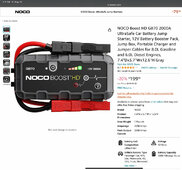squowse
Solar Enthusiast
- Joined
- Jan 4, 2021
- Messages
- 600
Oh I thought you were saying to not bother using fuses.then you can nothing do.
bms and fuse this is the maximum protection
Oh I thought you were saying to not bother using fuses.then you can nothing do.
bms and fuse this is the maximum protection
With those super cheap tyco disconnects at batteryhookup for around $15 no real reason not to.i don't have the necessary experience at the storage levels the OP had, but for me, If i was using a batrium, or orion I would have a separate BMS that could disconnect each string, just like I do know. i would also have a separate class T fuse for each battery string... just like i do now. the one thing I will add to my system as a takeaway from this is a mechanical relay/contactor whatever you call it for each string and it will be controlled via the current BMS's vice using the BMS to control the current directly. it might burn a little juice but over the last three years everyone of us at one time or another has made the claim you need to de-rate Chinese electronics to be safe... a 100 amp BMS is only good for 60 amps etc. etc. I have always de-rated mine and my current DALY 150 amp units rarely see more than about 15 amps each in discharge and maybe 35 each in charging and i felt that was good enough. now I want a mechanical contactor to take up the strain instead. just feel better with it.
There is nothing wrong from a safety perspective to have all string contactors controlled by the Batrium such that any failure isolates each string... beyond the nuisance factor.Orion recommends multiple redundant and independent methods of disconnection, and a contactor per string, I see nothing about the design of a Batrium where the dangers of multiple strings without the means to disconnect those strings wouldn't also apply to it.
I guess in theory the contactor shutoff could be considered the primary method of disconnection per string with a class t per string as the redundant backup? Or use two separate BMS and contactors?
Yes, if there had been a contactor per string, the Batrium could have disconnected the problem string.There is nothing wrong from a safety perspective to have all string contactors controlled by the Batrium such that any failure isolates each string... beyond the nuisance factor.
There really are three elements that are needed, but two can be combined easily: a means for the BMS to isolate a string, a means to interrupt currents in excess of the BMS or wiring rating, and a means to electrically isolate a string for maintenance. Great to have all those class-T fuses... but if one needs to be replaced and you have voltage drift between your strings I sure as hell wouldn't want to be putting the fuse in "hot." (My fear goes back to telecom strings though and we aren't talking about a 4,000A plant here.)
but if one needs to be replaced and you have voltage drift between your strings I sure as hell wouldn't want to be putting the fuse in "hot."
Considering the flat voltage curve of LFP, it's not really too big of a deal (yes, I've tested this).
My opinion …. The lack of surge is par for Lifepo design to remain controlled and stable with bms. Lacking uncontrolled high output of lead acid. Smaller cables too. I was amazed to see such small cables on bms….units.The Silicate batteries are interesting to potentially replace lead acid in below freezing conditions, both need to be only used to around 50% discharge for max life. Note in the listing it says "We parallel these with lithium batteries to give maxium surge capability" so maybe not as much current capability as LFP?

What did you read on this?not even pouches and prismatic type Lifepo.
Oh I thought you were saying to not bother using fuses.
Just my manufacturer notes from few other battery makers on websites. Which might just be them selling - marketing. My battery supplier stated do not add additional lifepo batteries in parallel after 6 months because of cell differences and wear tear mismatch. Again might be marketing.What did you read on this?
What problems could result?
I have one strong of each right now

 www.litime.com
www.litime.com
That means the wiring is sized to the load. Ppl leave that load part out…kinda criticalfuses wont protect the battery they protect the wiring.
because if a paralel shorted battery bank is charging from the others with less than the trip current of the fuse it wont help.
a bms is needed to protect the paralel bank and if you have the money a 2nd contactor for the paralel bank controlled by an other independent bms is the best protection.
but i havent seen two bms on each paralel battery bank.
some batrium users even have not a bms in each bank so they ignore the safety and risk their home or life. as you can see in the first post.
My situation is 8 commercial pre built pouch 50ah 48v batteries in parallel with 1 48v 280k set. I have a victron shunt on each set and the results are interesting.How do you clamp pouch cells?
Yikes - sounds like a misunderstanding of how Batrium works. Batrium is a central unit that monitors all individual cells in a powerwall (regardless of their 14s or 16s individual battery configurations) and in the aggregate the overall powerwall and provides a wide range of options to act on the metrics at both the cell level and the powerwall level. What one does when metrics get out of of bounds - e.g. trigger a global shunt-trip or individual battery shunt-trips or custom events is up to the user - not a deficiency in Batrium.some batrium users even have not a bms in each bank so they ignore the safety and risk their home or life. as you can see in the first post.
This cascading overload of individual BMSs might cause more trouble than it's worth.
exceeds
Thank you for sharing and helping us learn. Just curious, did you have cement backer board on the walls? If so, Do you know the thickness and brand? 3/8" hardybacker board? Thanks for sharing.Hi guys
-as already said, i can only post once in a while as i have a lot of other stuff going on right now
-when i was building my system, dividers between cells was not a thing yet. The thing back then was clamping cells or not. The cells have no spacers between.
-i will not participate in guessing games, my mind is not into that now, just want to give the facts.
-the cells were sitting on high density non conductive fibre boards, and metal parts of the rack got fibreboard as shieding to minimise contact issues
-dodgy heatshrink...i mean common, of course the back was cut off and completly free. If that was aan issue, it would have happened way sooner. The system was perfect for 4 years or so.
-and yes, of course i swapped the leaking cell.
-when i have a little spare time, ill pull the victron numbers
How would you feel if the fuse blew the night before and you didn't get around to replacing it until afternoon? The other strings would have charged up... Seems like I remember a video where someone got bit by doing a hot replace of the class T, but it might have been the main line between the inverter and the battery bankConsidering the flat voltage curve of LFP, it's not really too big of a deal (yes, I've tested this).
How would you feel if the fuse blew the night before and you didn't get around to replacing it until afternoon? The other strings would have charged up... Seems like I remember a video where someone got bit by doing a hot replace of the class T, but it might have been the main line between the inverter and the battery bank
Disconnect solar and let them settle (or wait until they drop under load), and then replace the fuse. They can be at different states of charge (say 30% and 80%) and still be at the same voltage.
Or have a contactor you can turn off
Yikes - sounds like a misunderstanding of how Batrium works. Batrium is a central unit that monitors all individual cells in a powerwall (regardless of their 14s or 16s individual battery configurations) and in the aggregate the overall powerwall and provides a wide range of options to act on the metrics at both the cell level and the powerwall level. What one does when metrics get out of of bounds - e.g. trigger a global shunt-trip or individual battery shunt-trips or custom events is up to the user - not a deficiency in Batrium.
This view that it's always good to disable a single battery within a group of parallel batterys in a powerwall (as apposed to disabling current for the overall powerwall) is not always thought out. Let's say an individual battery overloads and is disabled... this could cause a cascading overload of the other batteries as the overall load is now supported by less capacity. This cascading overload of individual BMSs might cause more trouble than it's worth.
Yes, as I explained above and it actually might have been what happened. Individual BMS's are not a guarantee this type of event won't occur.My point - it's not just as simple as always have 'individual battery automatic shut-off' or you're risking life and limb


